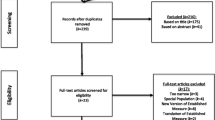Abstract
Objective
To examine the psychometric characteristics of the Italian language version of the latest edition of the eating disorder examination (EDE).
Methods
An Italian version of the EDE (17th edition) was designed and administered to 185 in- and outpatients with eating disorders and 60 age-matched controls. Its internal consistency, inter-rater reliability, short-term (7–23 days) test–retest reliability and criterion validity were evaluated.
Results
Internal consistency was high for all four original EDE subscales. Inter-rater reliability was excellent for global EDE scores and original subscales (≥0.93), and for eating disorder behaviours (≥0.89). Test–retest reliability was good for global EDE scores and original subscales (0.57–0.80), objective bulimic episodes and days, vomiting episodes, laxative and diuretic misuse episodes, and excessive exercising (≥0.82), but unsatisfactory for subjective bulimic episodes and days. Patients with eating disorders displayed significantly higher EDE scores than age-matched controls, demonstrating the good criterion validity of the instrument.
Conclusions
The Italian version of the EDE 17.0D has adequate psychometric properties and can therefore be recommended for examining Italian patients with eating disorders in clinical and research settings.
Similar content being viewed by others
References
Cooper Z, Fairburn CG (1987) The eating disorder examination: a semistructured interview for the assessment of the specific psychopathology of eating disorders. Int J Eat Disord 6:1–8. doi:10.1002/1098-108X(198701)6:1<1:AID-EAT2260060102>3.0.CO;2-9
Guest T (2000) Using the eating disorder examination in the assessment of bulimia and anorexia: issues of reliability and validity. Soc Work Health Care 31(4):71–83. doi:10.1300/J010v31n04_05
Wilson GT (1993) Assessment of binge eating. In: Fairburn CG, Wilson GT (eds) Binge eating: nature, assessment, and treatment. Guilford Press, New York, pp 227–249
Beumont PJ, Kopec-Schrader EM, Talbot P, Touyz SW (1993) Measuring the specific psychopathology of eating disorder patients. Aust N Z J Psychiatry 27(3):506–511. doi:10.3109/00048679309075810
Fairburn CG, Cooper Z, Doll HA, O’Connor ME, Bohn K, Hawker DM, Palmer RL (2009) Transdiagnostic cognitive-behavioral therapy for patients with eating disorders: a two-site trial with 60-week follow-up. Am J Psychiatr 166:311–319. doi:10.1176/appi.ajp.2008.08040608
Berg KC, Peterson CB, Frazier P, Crow SJ (2012) Psychometric evaluation of the eating disorder examination and eating disorder examination-questionnaire: a systematic review of the literature. Int J Eat Disord 45(3):428–438. doi:10.1002/eat.20931
Grilo CM, Crosby RD, Peterson CB, Masheb RM, White MA, Crow SJ, Wonderlich SA, Mitchell JE (2010) Factor structure of the eating disorder examination interview in patients with binge-eating disorder. Obesity (Silver Spring) 18(5):977–981. doi:10.1038/oby.2009.321
Byrne SM, Allen KL, Lampard AM, Dove ER, Fursland A (2010) The factor structure of the eating disorder examination in clinical and community samples. Int J Eat Disord 43(3):260–265. doi:10.1002/eat.20681
Grilo CM, Masheb RM, Lozano-Blanco C, Barry DT (2004) Reliability of the eating disorder examination in patients with binge eating disorder. Int J Eat Disord 35(1):80–85. doi:10.1002/eat.10238
Rosen JC, Vara L, Wendt S, Leitenberg H (1990) Validity studies of the eating disorder examination. Int J Eat Disord 9:519–528. doi:10.1002/1098-108X(199009)9:5<519:AID-EAT2260090507>3.0.CO;2-K
Rizvi SL, Peterson CB, Crow SJ, Agras WS (2000) Test–retest reliability of the eating disorder examination. Int J Eat Disord 28(3):311–316. doi:10.1002/1098-108X(200011)28:3<311:AID-EAT8>3.0.CO;2-K
Ravaldi CVA, Truglia E, Zucchi T, Mannucci E, Rotella CM, Faravelli C, Ricca V (2004) The eating disorder examination as a retrospective interview. Eat Weight Disord 9(3):228–231. doi:10.1007/BF03325072
Mannucci ERV, Di Bernardo M, Rotella CM (1996) Studio del comportamento alimentare con un’intervista strutturata: la Eating Disorder Examination. Il Diabete 8:127–131
Grilo CM, Lozano C, Elder KA (2005) Inter-rater and test-retest reliability of the Spanish language version of the eating disorder examination interview: clinical and research implications. J Psychiatr Pract 11(4):231–240
Grilo CM, Crosby RD, White MA (2012) Spanish-language eating disorder examination interview: factor structure in Latino/as. Eat Behav 13(4):410–413. doi:10.1016/j.eatbeh.2012.07.006
Frampton I, Wisting L, Overas M, Midtsund M, Lask B (2011) Reliability and validity of the Norwegian translation of the child eating disorder examination (ChEDE). Scand J Psychol 52(2):196–199. doi:10.1111/j.1467-9450.2010.00833.x
Fairburn CG, Cooper Z, O’Connor M (2008) eating disorder examination (edition 16.0D). In: Fairburn CG (ed) Cognitive behavior therapy and eating disorders. Guilford Press, New York, pp 265–308
American Psychiatric Association (2013) Diagnostic and statistical manual of mental disorders, 5th edn (DSM-5™). American Psychiatric Publishing, Arlington
Hilton A, Skrutkowski M (2002) Translating instruments into other languages: development and testing processes. Cancer Nurs 25(1):1–7
Cooper Z, Cooper PJ, Fairburn CG (1989) The validity of the eating disorder examination and its subscales. Br J Psychiatry 154:807–812. doi:10.1192/bjp.154.6.807
Conflict of interest
None declared.
Author information
Authors and Affiliations
Corresponding author
Rights and permissions
About this article
Cite this article
Calugi, S., Ricca, V., Castellini, G. et al. The eating disorder examination: reliability and validity of the Italian version. Eat Weight Disord 20, 505–511 (2015). https://doi.org/10.1007/s40519-015-0191-2
Received:
Accepted:
Published:
Issue Date:
DOI: https://doi.org/10.1007/s40519-015-0191-2



